Retreat in the California High Desert
Our Joshua Tree Holiday
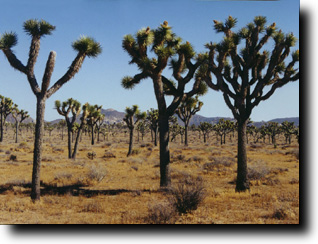 By Maireid Sullivan By Maireid Sullivan
March 2001, Marina del Rey, California
Ben and I took a trip to the Joshua Tree High Desert for a few days, to celebrate the completion of two years work on Ben's book, "Electronic Music Pioneers."
Joshua Tree National Park is situated in the high desert, where the
low Colorado Desert and the high Mojave Desert meet in Southern California.
The best place to see the sunset
is at Key's View lookout, about 22 miles from the Northern Entrance gate in
29 Palms.
When we arrived at Key's View lookout at 5:15AM, there were no other people around. As Ben was about to get out of the car, to his surprise there on the ground
in front of him was a "Dreamcatcher" in perfect condition,
made of pale green suede with lovely slender soft feathers and pale
beads. In native tradition a Dreamcatcher is hung near the sleeping
area in the lodge. It is believed to sort dreams. The good dreams would
take the path of the web with great ease to its center and would float
gently, like a feather, into the minds of the sleepers. The
bad dreams would become entangled in the web and perish in the rays
of the morning sun. Native Americans sometimes carry them in dances
and ceremonies. We decided to hang our token of welcome on the rear
view mirror in the car until we got home.
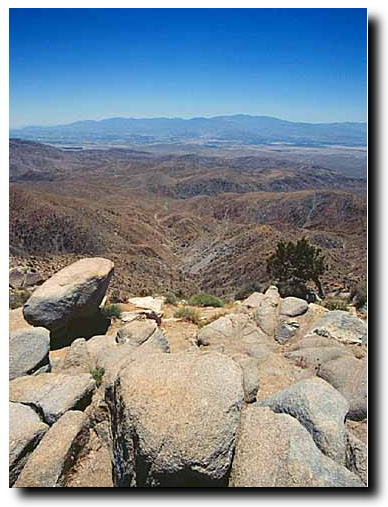
Spring in the high desert peaks over the last
two weeks of March into the first two weeks of April. Heavy rains pour down during the first two weeks of
March, bringing the desert to life with multi-colored tiny flowers: shades of white and pink and royal
blue and purple and orange that Georgia O'Keefe might have wanted to
magnify in her paintings, to help us to see their perfect glorious form. Binoculars magnify the experience of
the mystical nature of the light and color.
The first warm rays of light melt the ice, and colorful soft mists slowly rise up with the light across the valleys and plateaus. During the cool of the morning, it is easy to spend four to five hours, driving very
slowly from plateau to plateau, and stopping to walk further in to study the plants more closely.
Joshua Trees are the epitome of primordial 'antlered trees' -- teaming
with life under an inch thick crusty bark, scattered in a setting of
boulder formations, the likes of which I have never seen before, at the top
of the Little San Bernardino mountain range. The green spiked tops of
these trees look like they might be succulent but they are as hard as
wood.
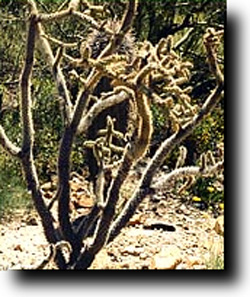
Not far away are other separate exotic cactus plant clusters, such as
the magnificent looking tall flame flower-tipped Ocotillo, the trunk
and branches of which are completely covered right now by little four-leaf
clover-like soft green petals that drop off in the summer heat, leaving
the impression that the plant is dead when it is only dormant.
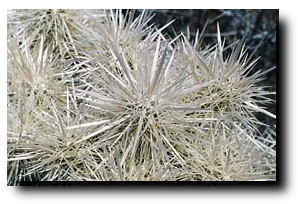
And then
there is the Chollo, or "jumping cactus", which has thousands
of needles attached to them to help break up the rays of the sun, creating
an aura of primordial beauty. There is a carefully laid path
through a large section of this 'garden', as one must be very careful
not to touch them or brush up against them. We touched one with a stone
to sense it's dense and heavy hardness under the spikes.
Have you ever
stood in the middle of a vast high desert plateau -- at dawn, equal
distance from the surrounding black mountain silhouettes that shield
the valley, with arms raised in praise and thanks for the good earth
and the clear air that floods the lungs? We watched in awe as the shadows
lifted and the morning light swept slowly over the mountains, as each
mountain range gave way to new plateaus and misted distant vistas, through
shadow-formed cascades that were a divinity to behold in the still air
and the light of dawn. It had a dreamtime personality to it: A great
sense of timelessness -- through millions of years of life on earth.
I felt shivers run through me as I felt its immensity and invincibility.
As I recall the most affecting moments of insight I realize that I cannot
describe them. Along the road there are discrete little information
displays describing the unique features of each area. The first one,
just past the Cottonwood Mountains, posted this statement. "The
native tribes of the Serrano, Cahuella and Chemehuevi settled here.
...They knew the secrets of where and how to hunt big horn sheep, antelope,
rabbits, etc., and to gather nuts, beans, acorns, fruit, grubs and insects,
etc. and they jealously guarded the location of springs and rain catchments.
...These people are gone forever, except for scattered traces such as
pictographs, chipped stone and bone and bedrock mortar, and tales passed
on by old-timers, who remember their final days." I was really
moved by the line "...and tales passed on by old-timers who remember..."
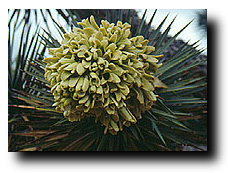
Long
eons ago the earliest known settlers of this area, known to us as Pinto
Man, left traces of settlement during a time when this area was not
desert at all, but was rich in water and plant life.
Each morning we exited the park at Joshua Tree, and headed for breakfast at
the Country Kitchen, on the recommendation of friends who live in Joshua Tree— on the corner of 29 Palms
Highway and Park Blvd, at the west entrance to the park. After four
or five hours roaming on the top of the high plateau, it was nice to come
down to 2700 ft. for a great breakfast at this cozy little place.
Avoiding the intolerable middle day heat, we stayed at Desert Hot Springs (Miracle Springs Spa) where the pools
are filled with mineral hot spring waters - for
soaking and drinking.
Desert Hot Springs rests upon a huge alluvial plain filled by the ancient
Mission Creek, which flows from the snow pack on Mt. San Gorgonis, which is a
protected natural preserve, to the five-mile deep Mission Creek Aquifer.
This is the sole source of drinking water at Desert Hot Springs. The
hot mineral water flows from the Desert Hot Springs Aquifer next to
the Little San Bernardino Mountains. Hundreds of thousands of gallons
of this water are heated by the magma of the earth and flow up to the
surface each day, at temperatures ranging from 90 and 144 degrees F,
from fissures that extend down to the molten interior of the earth.
This
water elixir is famous for its curative qualities. It is rated among
the best-untreated curative waters in the world. So you can imagine
that our minds were at rest as we soaked in the pools and spas each
afternoon and drank as much of the water as we could hold.
Twenty Nine palms is about 135 miles east from Downtown Los Angeles,
but to get there you have to drive for over two hours in heavy traffic on the 10
freeway, through the worst urban sprawl in the world.
You could fly to Palm Springs! Palm Springs has limited nature access: the Indian Canyons to the south, but this is controlled access where a tour guide is required and only between 9 and 5pm (which is the time when people like me have to
keep out of the sun).
You can also stay up in Joshua Tree or 29 palms. There are several motels
there. Twenty-Nine Palms Inn is very good and it is situated
just next to the Northern entrance to the park, on the Oasis of Mara.
There are two or three campsites in the park as well. And, it is best
to go during the week when there are fewer visitors. Spring is the time
for new growth, especially during the last two weeks of March and the first two weeks of April.
Joshua Tree and Indian Springs Photos
back to top
Ben looking up at a Joshua Tree, full moon dawn: photos taken 5:30 a.m.-7.a.m
back to top
|

